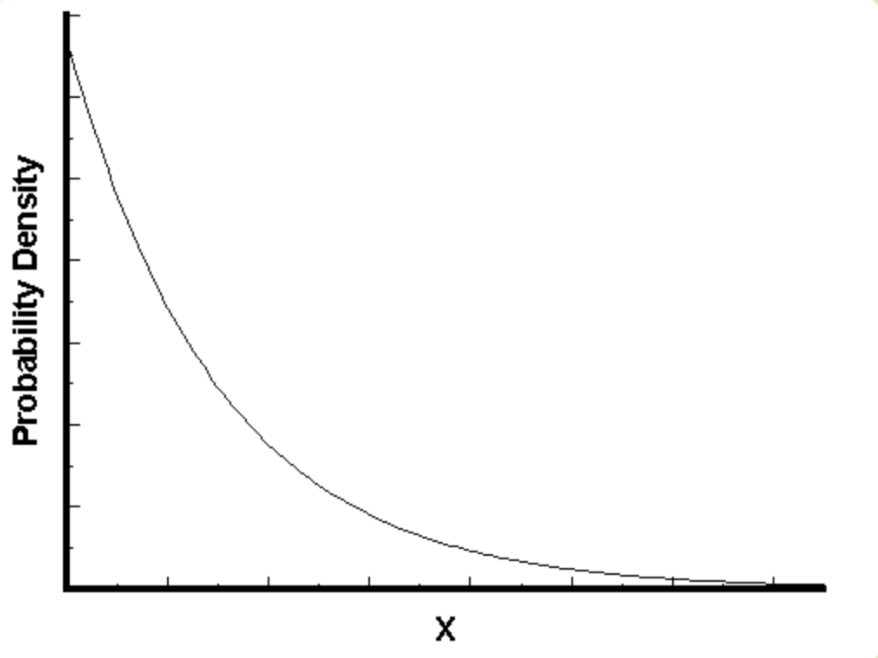backoff 退避算法
学习公司服务发现框架时,发现有用到 exponential jitter backoff 这个算法,这里来学习一下
实际上这种算法的应用场景就是用来取得最优的重试时间,例如某个服务暂时离线,这种时候得不断的重试,那如何设置这个重试的时间间隔呢?
而常见的 ”重修->休息->重试” 的算法叫做 backoff 退避算法。所以什么是 backoff 呢?
从重试场景看,就是用某种算法,找到一个合理的重试时间,而不是所有异常请求都一窝蜂的直接去重试
大部分重试、重发等场景都会利用 backoff 算法来降低冲突和无谓的资源消耗
backoff 的常见算法
backoff 基本都需要设定最大重试次数或者最大间隔时间。因为无限次的重试往往没有意义,过长的间隔时间也不利于响应下游的恢复
backoff 算法有以下几种常见实现方式:
fixed backoff
固定间隔时间的退避算法。每次重试都会间隔固定的 interval 时间
优点:实现非常简单 缺点:interval 不太好设定。设置的过小,下游长时间的故障可能造成大量资源浪费;设置的过大,对于偶现的网络抖动不能及时投递数据
random backoff
给定一个重试等待的最大时间 maxInterval,直接随机一个等待时间出来。范围是 [0,maxInterval),比较暴力
优点:实现非常简单,较好的避免冲突 缺点也很明显:可能一次偶然的网络抖动,却等待了相当长一段时间才重试成功
fibonacci backoff
基于 fibonacci 数列的退避算法。能较好的避免冲突,及时响应短暂的下游故障
核心算法:
next := prev + prevPrev
prevPrev = prev
prev = next
return next
输出结果如下:
=== RUN TestFibonacci_Next
0ms
10ms
10ms
20ms
30ms
50ms
80ms
130ms
优点:能够快速恢复数据投递。适合下游故障能够快速恢复或者故障率很低的情况 缺点:对于下游较长时间的故障,比较浪费资源
exponential backoff
指数退避算法。也就是每次重试的间隔时间都是指数增长的。那为什么是指数增长呢?

可以看到,随着间隔时间变长,事件的发生概率急剧下降,呈指数式衰减,所以,指数退避算法随着重试次数的增加,时间间隔变长,发生冲突的概率是非常低的。因此很适合作为 backoff 的一种实现算法
核心代码如下:
// minInterval: 表示初始的时间间隔。例如 10ms
// factor: 表示指数因子。例如 2
// attempts: 表示重试的次数
next := float64(minInterval) * math.Pow(factor, attempts)
输出结果如下:
=== RUN TestExponential_Next
10ms
20ms
40ms
80ms
160ms
320ms
640ms
1280ms
...
优点:实现比较简单。同时冲突的概率也很低,在重试初期可以在相对比较短的时间内完成。对于服务宕机时间较长的情况,也可以在一个稳定的长时段内重试,不会空耗系统资源 缺点:当大部分节点恰好都在同一个时间点发生异常,那由于每次重试的间隔时间都是一致的会导致容易发生冲突
exponential jitter backoff
指数抖动退避算法,就是弥补指数退避算法的缺点。每次计算出下一次重试的间隔时间的时候加上一定的随机抖动时间,使同一时间需要重试的请求错开
核心代码:
// minInterval: 表示初始的时间间隔。例如10ms
// factor: 表示指数因子。例如2
// attempts: 表示重试的次数
// jitterFactor: 表示抖动的因子。例如0.5
next := float64(minInterval) * math.Pow(factor, attempts)
if jitterFactor > 0 {
j := jitterFactor * next
min := next - j
max := next + j
next = min + rand.Float64()*(max-min+1)
}
输出结果如下:
=== RUN TestExponential_NextWithJitter
11ms
28ms
46ms
75ms
147ms
379ms
362ms
840ms
代码实现
在 github 上发现一个较好的实现. github.com/jpillora/backoff
// Package backoff provides an exponential-backoff implementation.
package backoff
import (
"math"
"math/rand"
"time"
)
// Backoff is a time.Duration counter, starting at Min. After every call to
// the Duration method the current timing is multiplied by Factor, but it
// never exceeds Max.
//
// Backoff is not generally concurrent-safe, but the ForAttempt method can
// be used concurrently.
type Backoff struct {
//Factor is the multiplying factor for each increment step
attempt, Factor float64
//Jitter eases contention by randomizing backoff steps
Jitter bool
//Min and Max are the minimum and maximum values of the counter
Min, Max time.Duration
}
// Duration returns the duration for the current attempt before incrementing
// the attempt counter. See ForAttempt.
func (b *Backoff) Duration() time.Duration {
d := b.ForAttempt(b.attempt)
b.attempt++
return d
}
const maxInt64 = float64(math.MaxInt64 - 512)
// ForAttempt returns the duration for a specific attempt. This is useful if
// you have a large number of independent Backoffs, but don't want use
// unnecessary memory storing the Backoff parameters per Backoff. The first
// attempt should be 0.
//
// ForAttempt is concurrent-safe.
func (b *Backoff) ForAttempt(attempt float64) time.Duration {
// Zero-values are nonsensical, so we use
// them to apply defaults
min := b.Min
if min <= 0 {
min = 100 * time.Millisecond
}
max := b.Max
if max <= 0 {
max = 10 * time.Second
}
if min >= max {
// short-circuit
return max
}
factor := b.Factor
if factor <= 0 {
factor = 2
}
//calculate this duration
minf := float64(min)
durf := minf * math.Pow(factor, attempt)
if b.Jitter {
durf = rand.Float64()*(durf-minf) + minf
}
//ensure float64 wont overflow int64
if durf > maxInt64 {
return max
}
dur := time.Duration(durf)
//keep within bounds
if dur < min {
return min
}
if dur > max {
return max
}
return dur
}
// Reset restarts the current attempt counter at zero.
func (b *Backoff) Reset() {
b.attempt = 0
}
// Attempt returns the current attempt counter value.
func (b *Backoff) Attempt() float64 {
return b.attempt
}
// Copy returns a backoff with equals constraints as the original
func (b *Backoff) Copy() *Backoff {
return &Backoff{
Factor: b.Factor,
Jitter: b.Jitter,
Min: b.Min,
Max: b.Max,
}
}
使用例
import "math/rand"
b := &backoff.Backoff{
Jitter: true,
}
rand.Seed(42)
fmt.Printf("%s\n", b.Duration())
fmt.Printf("%s\n", b.Duration())
fmt.Printf("%s\n", b.Duration())
fmt.Printf("Reset!\n")
b.Reset()
fmt.Printf("%s\n", b.Duration())
fmt.Printf("%s\n", b.Duration())
fmt.Printf("%s\n", b.Duration())
100ms
106.600049ms
281.228155ms
Reset!
100ms
104.381845ms
214.957989ms